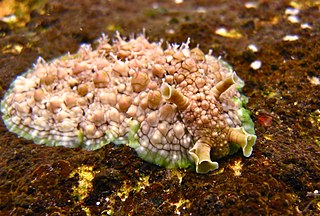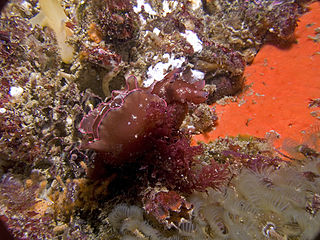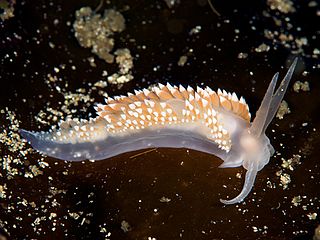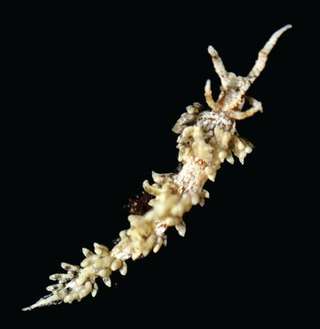
The clade Anaspidea, commonly known as sea hares, are medium-sized to very large opisthobranch gastropod molluscs with a soft internal shell made of protein. These are marine gastropod molluscs in the superfamilies Aplysioidea and Akeroidea.

Aplysiidae is the only family in the superfamily Aplysioidea, within the clade Anaspidea. These animals are commonly called sea hares because, unlike most sea slugs, they are often quite large, and when they are underwater, their rounded body shape and the long rhinophores on their heads mean that their overall shape resembles that of a sitting rabbit or hare. Sea hares are however sea snails with shells reduced to a small plate hidden between the parapodia, and some species are extremely large. The Californian black sea hare, Aplysia vaccaria is arguably the largest living gastropod species, and is certainly the largest living heterobranch gastropod.

Bursatella leachii, whose common name is the ragged sea hare or shaggy sea hare, is a species of large sea slug: a marine gastropod mollusk in the sea hare family Aplysiidae. It has an almost pantropical distribution, from the Mediterranean to the Caribbean, but excluding the central and eastern Pacific Ocean. Its long planktonic larval period and short life cycle make able to colonise new areas and increase dramatically in number if food supplies are favourable.

Syphonota geographica, or the geographic sea hare, is a species of sea slug or sea hare, a marine opisthobranch gastropod mollusk in the family Aplysiidae, the sea hares.

Dolabrifera brazieri is a species of sea slug or sea hare, a marine opisthobranch gastropod mollusc in the family Aplysiidae, the sea hares.

Aplysia dactylomela, the spotted sea hare, is a species of large sea slug, a marine opisthobranch gastropod in the family Aplysiidae, the sea hares.

Aplysia juliana, the walking sea hare, is a species of sea hare, a marine gastropod in the family Aplysiidae.

Cadlina laevis, common name the white Atlantic cadlina, is a species of sea slug, a dorid nudibranch, a shell-less marine gastropod mollusk in the family Cadlinidae.

The dwarf sea hare or pygmy sea hare, Aplysia parvula, is a species of sea hare, a marine gastropod mollusc in the family Aplysiidae.

Doris verrucosa is a species of sea slug, a dorid nudibranch, a marine gastropod mollusk in the family Dorididae.

Dolabella auricularia, also known as the wedge sea hare, is a species of large sea slug, a marine opisthobranch gastropod mollusk in the family Aplysiidae, the sea hares.

Aplysia vaccaria, also known as the black sea hare and California black sea hare, is a species of extremely large sea slug, a marine, opisthobranch, gastropod mollusk in the family Aplysiidae. It is the largest sea slug species.

Cadlina rumia is a species of sea slug or dorid nudibranch, a marine gastropod mollusk in the family Cadlinidae.

Coryphella verrucosa, is a species of sea slug, an aeolid nudibranch, a marine gastropod mollusc in the family Coryphellidae.

Doto escatllari is a species of sea slug, a nudibranch, a marine gastropod mollusc in the family Dotidae.

Lomanotus vermiformis is a species of sea slug, a marine gastropod mollusk in the family Lomanotidae.

Trapania dalva is a species of sea slug, a dorid nudibranch, a marine gastropod mollusc in the family Goniodorididae.

Palisa papillata is a species of sea slug, specifically an aeolid nudibranch. It is a marine gastropod mollusc in the family Facelinidae. It is the only species in the genus Palisa.

Doto chica is a species of sea slug, a nudibranch, a marine gastropod mollusc in the family Dotidae.

Dolabrifera nicaraguana is a tropical species of sea hare found in the Eastern Pacific Ocean.






















